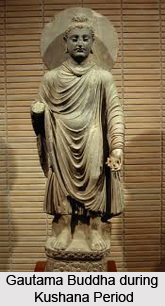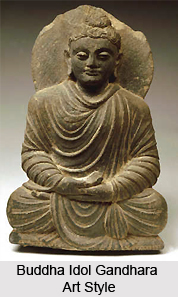 The Mathura Buddhas represent one of the finest developments in Indian art. It is not just a diachronic sculpture but a medieval Indian sculptural descriptor where Buddha is depicted as just not a historical figure but a figure worthy of bowing down. The Mathura Buddhas were quite different from the Gandhara ones. In fact it can be said that Lord Buddha was for the first time represented in human form in the Mathura and Gandhara Schools of Art.
The Mathura Buddhas represent one of the finest developments in Indian art. It is not just a diachronic sculpture but a medieval Indian sculptural descriptor where Buddha is depicted as just not a historical figure but a figure worthy of bowing down. The Mathura Buddhas were quite different from the Gandhara ones. In fact it can be said that Lord Buddha was for the first time represented in human form in the Mathura and Gandhara Schools of Art.
Some of the characteristics of the Mathura Buddha were the ushnisa, which is thought to be the wisdom bump on top of his head. Coils of hair were arranged over it. There was the urna, which was supposed to be a curl of hair on the forehead. This is portrayed like a dot almost like the all-seeing third eye of the gods. And finally, there were the elongated ears of the Buddha. There were many other signs as well. The Mathura figures, on the other hand, are broad-shouldered and powerfully built. In the Mathura figures, the hair fits like a cap and the topknot is coiled like a snail. The drapery falls over the left shoulder leaving, the right shoulder bare. Another important characteristic of Mathura Buddha is that Mathura sculptures were from red sandstone spotted and veined with yellow.
The standing Mathura Buddha is a colossal statue wearing monastic robes. The transparent robes which is carved with circular lines once again points at his masculine body. The transparent robes carved with deeply etched circular lines also point to a strong physique. The right shoulder is bare as the left shoulder is draped elegantly.

The Seated Buddha at the Mathura Museum belongs to the 2nd Century AD. He has a serene, smiling face and eyes that look directly at the viewer. Lord Buddha is seated with his legs crossed and hands lay in the lap. The robes, worn over the left shoulder and arm, cover a part of the chest and most of the lower part of the body. a twisted coil of hair or bun corresponding to the later cranial bump on the head complements with the yogic posture of the Mathura Buddha. The soles of Buddha`s feet are turned upwards in what is known as Padmasana or lotus position and they are marked with Buddha`s symbols. His left hand is resting on his knee while his right hand is raised with the palm outwards in the Abhaya Mudra. This position was a model for almost all the seated figures.
The halo behind Buddha`s head in Mathura, signalling his divinity, is marked with a scalloped design on the edge. In the background, there is the foliage of peepal tree, also a symbol of Buddha as he attained enlightenment. The lively naturalism with which the leaves are treated is a treat for the eyes.



















